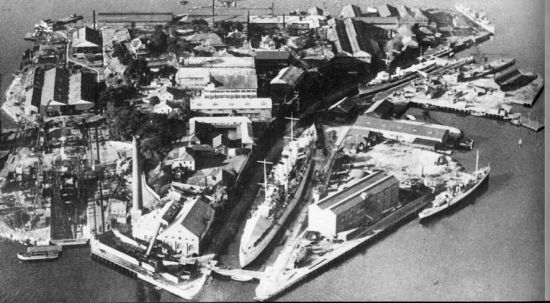- Author
- Ward, Samantha
- Subjects
- History - general, Ship design and development
- Tags
-
- RAN Ships
- None noted.
- Publication
- June 2003 edition of the Naval Historical Review (all rights reserved)
The incredible scale of the work undertaken by the dockyard during these years can be judged by the following: the ships converted and refitted were arranged to carry in total 4,459 officers, 5,900 non-commissioned officers, 112,500 men, 1,800 munition workers and navvies and 17,000 horses. ((p 29 Cockatoo Island: A History, by R.G Parker)) Refitting work continued on a large scale after the war to return the ships and other vessels to their previous duties.
1920s
Whilst the war years had proved very lucrative for the dockyard, construction work diminished in the 1920s to such an extent that it was difficult to run the dockyard at a profit. Attempts were made to get commercial engineering projects for the dockyard to keep the employees gainfully employed. However, the High Court intervened for constitutional reasons. It argued that Cockatoo Island, as a government instrumentality, could not compete with private enterprise. These limitations forced the Government of the day to consider leasing out the dockyard and the plant. In 1923, the management and control of Cockatoo Island, in accordance with the provisions of the Commonwealth Shipping Act 1923, was transferred to the Australian Commonwealth Shipping Board. In 1933, Cockatoo Island was leased to a newly formed Australian Company: The Cockatoo Docks and Engineering Company Limited.
1929-33
Wing-Commander L.J. Wackett, the celebrated aeronautical engineer and aircraft designer, was behind this unusual activity on Cockatoo Island. Numerous repairs were undertaken on various aircraft, the largest project being the rebuilding of the Southern Cross in which Sir Charles Kingsford Smith had flown the Pacific. Sixty percent of the plane had to be rebuilt after crashing when landing at Mascot on 19 March 1932.
1933
During the 1920s shipbuilding had slowed down, but picked up again just before the outbreak of World War II. The Commonwealth ordered the construction of a naval escort vessel HMAS Yarra, followed by HMAS Swan. HMAS Adelaide was modernised, as was HMAS Australia, which was fitted with additional side armour. The liner Moreton Bay was converted into an armed merchant cruiser, whilst another vessel, the Changte, was converted into a victualling supply ship.

During the war years dockyard activity at Cockatoo Island was frantic, as the island became the major shipbuilding and dockyard facility for the Pacific region after the fall of Singapore. Hundreds of ships from the RAN and US Navy were docked at Cockatoo for refitting and repairs. Wartime dockings totalled 750 vessels, of which 395 were merchant ships and 350 were naval ships. Work was particularly lengthy because many of the ships were seriously damaged and required long periods in dry dock. Eleven RAN ships required repairs including Australia and Hobart. Hobart had suffered extensive damage, notably to the stern, which was only just hanging on with two propellers and shafting blown off. Australia had suffered considerable damage after being attacked by Kamikaze pilots at the Philippine landings.
1947
This year marked an important change for Cockatoo Island. Vickers Limited, an engineering company based in London took over the majority of the shares in the Cockatoo Docks and Engineering Company Pty Ltd. Vickers had been invaluable to Cockatoo during World War II, providing much needed technical aid and training support.
1948
The Daring class destroyer program began. These were based on a British design. Voyager and Vampire were built at Cockatoo and completed by the late 50s. It was the first time ‘all-welded’ hulls were to be built in Australia. Lack of expertise in this area meant that some of Cockatoo’s technical staff was sent to the United Kingdom to learn the new techniques required. Cockatoo gained a lot of experience in all-welded ship construction and became a leader in the field, advising shipyards throughout Australia. The increased threats from both air and submarine attack meant the destroyer had greater defence responsibilities. The destroyers provided aircraft carrier escort, and gunfire support to the Fleet. Their strong, light construction combined high speed with maximum armament, which included the big guns, lighter anti-aircraft guns, torpedo launchers and anti-submarine mortars. HMAS Voyager sank after a tragic night-time collision with HMAS Melbourne when routine manoeuvres went tragically wrong. Voyager was cut in two, leading to the death of 82 sailors.
1950s
Construction of Type 12 frigates commenced. HMA Ships Parramatta and Stuart were completed by 1961 and 1963 respectively. Their peacetime role involved patrolling and surveillance; escort duties in ocean and coastal water; command and control of maritime forces and navigation and seamanship training. They were considered to be very sophisticated frigates. Stuart was the first ship to be fitted with the IKARA anti-submarine guided missile. IKARA was an innovative Australian development that was later adopted by foreign navies.




